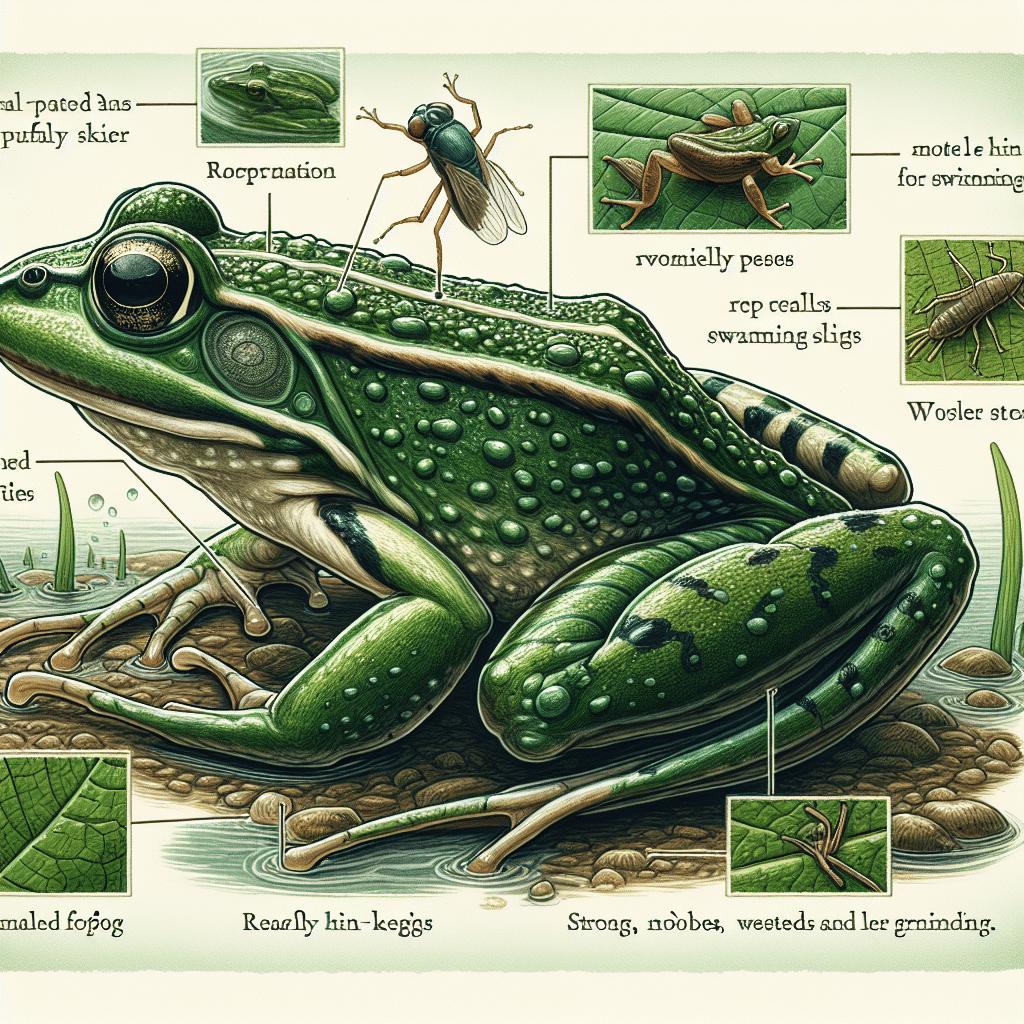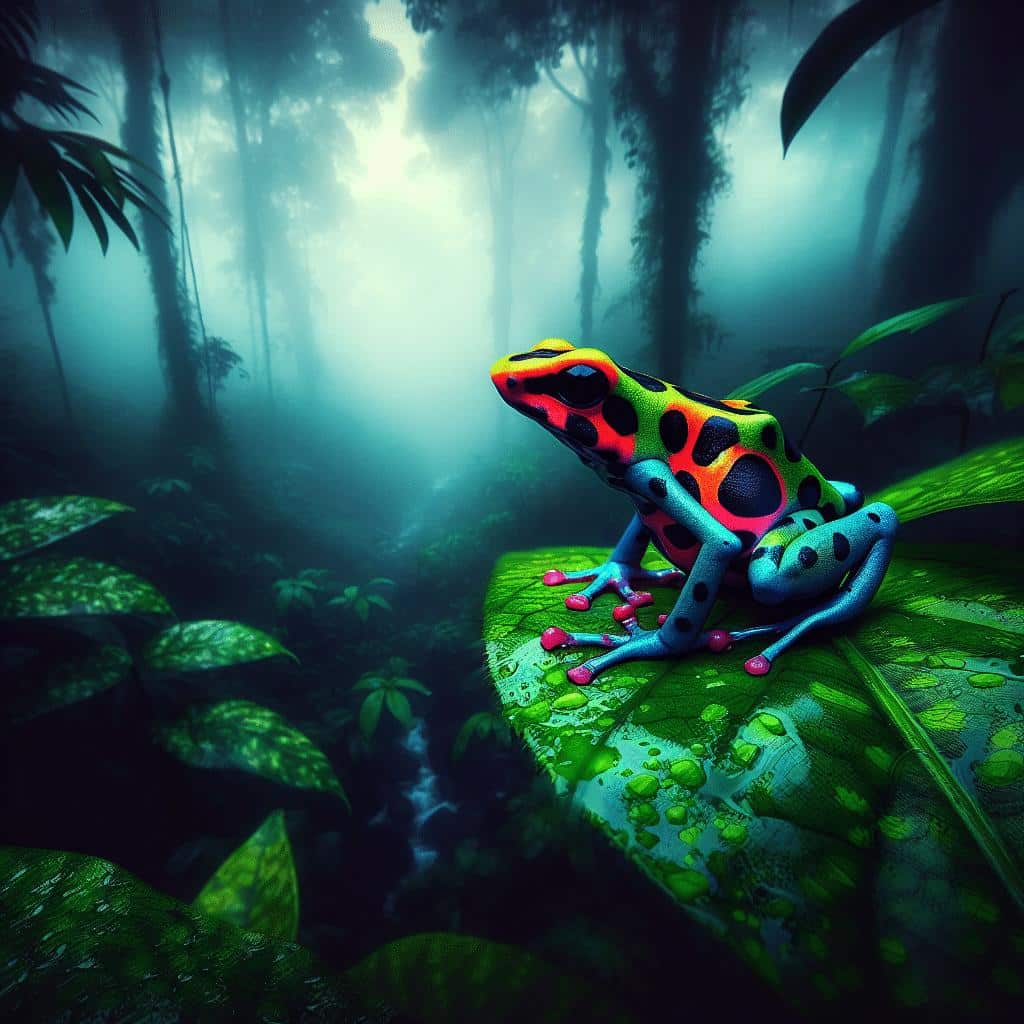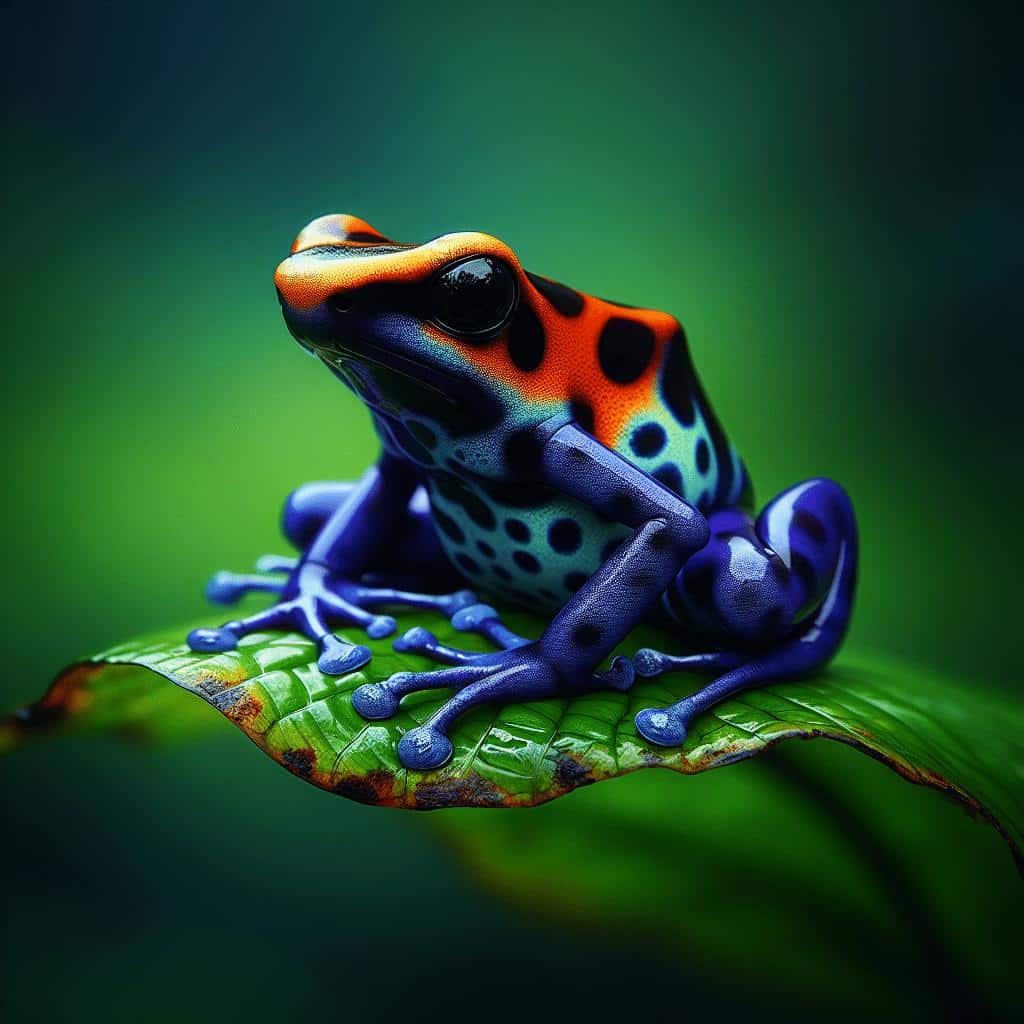Jump right in and get ready to learn all about the fascinating features of frogs! In this article, you’ll discover the unique traits that set these amphibians apart from their land-loving cousins. From their powerful legs designed for expert leaping to the curious lifecycle that takes them from water-bound tadpoles to land-hopping adults, you’re about to explore the world of these ribbiting creatures like never before. Experience the elegance of their moist skin, understand the function of their bulging eyes, and get a glimpse of their incredible adaptability in diverse environments across the globe. Prepare to be amazed by what makes frogs so uniquely suited to their amphibious way of life.

Anatomical Features
When you look at a frog, you’re looking at a creature whose anatomy has evolved over millions of years to suit a semi-aquatic lifestyle. Frogs are fascinating animals, and their bodies are perfectly suited for the environments they inhabit.
General body structure
Your typical frog has a stout, compact body with a large head and wide mouth. The eyes often bulge out, and they have a short vertebral column without much of a tail. This structure makes them excellent at absorbing impacts when they land after a jump.
Skin texture and function
Have you ever touched a frog? If so, you might have noticed their skin is moist and slippery. That’s because frogs have a thin, permeable skin that can absorb water and oxygen directly from the environment. This skin needs to stay moist for them to breathe properly, which is why you often find frogs near water.
Limbs and locomotion
When you see a frog jump, you’re witnessing a marvelous feat of locomotion. Frogs have powerful hind legs that are long and muscular, designed for leaping. Their front legs are shorter and work as shock absorbers when they land. They even use their legs to swim, making powerful kicks with their hind limbs.
Adaptations for jumping
Beyond strong muscles, frogs have specially adapted pelvic bones and elongated ankle bones, affording them greater leverage for jumping. The tendons in their legs work like springs, storing and releasing energy during jumps.
Respiratory system variations
Your breathing apparatus as a human is simple – you breathe in and out using your lungs. Frogs, however, can also breathe through their skin, a process called cutaneous gas exchange. This is especially important when they’re underwater and can’t access air.
Sensory organs
Frogs have remarkable sensory organs. Their eyes can see in nearly every direction without having to move their head. Did you know that they can also sense vibrations through the ground? This ability helps them detect prey or predators nearby. Their sense of hearing is also keen; they have an eardrum (tympanum) on the outside of their body, picking up sound waves efficiently.
Physiological Adaptations
Frogs are remarkable for their physiological adaptations, which allow them to thrive in diverse environments and conditions.
Ectothermic metabolism
Frogs are ectotherms, which means their bodies don’t produce much internal heat. They rely on the environment to regulate their body temperature. This can be challenging but also means they require less energy to survive compared to warm-blooded animals.
Hydration and water retention
Considering how important water is for their skin, you might wonder how frogs manage in dry environments. They’ve adapted by having a high surface absorption of water and some species can even burrow underground to retain moisture.
Camouflage and skin color changes
Your average frog is a master of disguise. Their ability to camouflage is vital for avoiding predators. Some frogs can even change color based on their surroundings or their mood, thanks to special pigment cells called chromatophores in their skin.
Hibernation and estivation
To survive extreme temperatures, frogs can enter hibernation or estivation. Hibernation is for cold spells – they’ll dig into the mud or find a crevice to wait out the freeze. Estivation is similar but it’s to escape the heat; frogs might bury themselves to stay cool and conserve moisture.
Reproductive Characteristics
Now, the ways in which frogs ensure the survival of their species is quite the riveting topic.
Breeding behaviors
During the breeding season, male frogs often call to attract females. The sounds range widely in pitch and pattern. You’ve probably heard this chorus on a warm night near a pond or creek.
Eggs and development
Frog eggs are something else! Females lay jelly-like clusters or strings of eggs in water. These eggs, often called spawn, develop into tadpoles before they become adult frogs.
Tadpole metamorphosis
The change from tadpole to frog is one of the most dramatic metamorphoses in the animal kingdom. Initially, tadpoles are like fish – they have gills and tails and live entirely in water. Gradually, they grow legs, lose their tails, develop lungs, and morph into adult frogs.
Sexual dimorphism
In many frog species, males look different than females, known as sexual dimorphism. Common differences include size, color, and the presence of skin folds or pads used for gripping during mating.
Parental care variations
Some frog species offer no parental care after laying eggs; others might carry eggs on their back, in their mouths, or even inside their stomachs! Parental behavior varies widely among frog species.

Dietary Habits
Now let’s talk about what frogs eat because their diets are as interesting as their jumps.
Typical diet
You’re probably picturing a frog snagging a fly with its tongue, right? Well, that’s accurate for many species. Frogs mainly eat insects, but some larger frogs can eat other animals like mice, small birds, or even other frogs.
Feeding mechanisms
Frog tongues are fascinating. They are attached to the front of their mouth and can be launched forward to catch prey. Their eyes even help them eat by retracting into their head and pushing the food down their throat.
Digestive system
Once food is caught, it passes through the esophagus into the stomach, enters the small intestine where nutrients are absorbed, and then the waste moves into the large intestine. Pretty standard, but very effective.
Role in the food chain
Frogs play a dual role in the food chain: they control insect populations as predators, and they also serve as prey for higher animals like birds, snakes, and even other frogs. They maintain the balance in their ecosystems excellently.
Habitat and Distribution
Frogs can be found in nearly every corner of the world, thanks to their amazing adaptability.
Diverse habitats
From tropical rainforests to arid deserts, frogs have adapted to an impressive range of environments. They can be found near ponds, in trees, underground, and even in snowy mountains.
Geographical spread
While frogs are spread out across the globe, their diversity is highest in tropical regions where humidity and temperatures are ideal for their survival.
Adaptation to environment
Frog adaptations are specific to their homes. For example, tree frogs have sticky pads on their toes for climbing, while desert frogs can burrow to escape heat.
Territorial behavior
Not all, but some frog species are territorial. They’ll guard a particular area against others of the same species, often to secure a prime spot for attracting a mate and breeding.
Behavioral Traits
Frogs have quite a few tricks up their, well, they don’t have sleeves, but they have behavioral traits!
Communication methods
Aside from the well-known croaks and ribbits, frogs can also communicate through body postures and movements. Some even have vocal sacs that they inflate to make sounds that can travel long distances.
Predator avoidance strategies
Being small and tasty comes with risks. Frogs have developed various strategies for avoiding predators, such as playing dead, jumping abruptly to confuse attackers, or secreting toxins.
Social structures
Frogs can be social or solitary, depending on the species. Some form groups during breeding seasons, while others maintain a more hermit-like existence.
Daily and seasonal activity patterns
Frogs are generally more active during the night, which is known as being nocturnal. However, some are diurnal (active during the day) or crepuscular (active during dawn and dusk). Their activity can also change with the seasons, particularly for species living in areas with large temperature variations.
Ecological Significance
The role of frogs in their ecosystems cannot be overstated.
Indicator species
Frogs are excellent indicator species, meaning scientists can study them to gauge the health of an ecosystem. This is because of their permeable skin that reacts quickly to environmental changes.
Biodiversity and ecosystem roles
Frogs contribute to biodiversity and the balance of ecosystems. They help control insect populations and are a food source for numerous predators, playing vital roles in the food web.
Interaction with other species
Through their daily living and feeding habits, frogs interact with countless other species, influencing the survival and evolution of plants and animals in their habitats.
Evolutionary Aspects
The story of frogs is deeply rooted in the history of life on Earth.
Evolutionary history
Frogs have been hopping around for a very long time. They’re descendants of some of the earliest amphibians to adapt to land, with a lineage stretching back over 250 million years.
Adaptive radiation
Throughout their history, frogs have undergone adaptive radiation – they have diversified and adapted to fill a wide range of ecological niches around the world.
Phylogenetic relationships
The phylogenetic tree of frogs – their evolutionary family tree – reveals their relationships to each other and to other amphibians. It’s a complex web that shows just how diverse they’ve become.
Fossil record
The fossil record for frogs provides evidence of their ancient ancestors and gives scientists insights into how they’ve evolved over the millennia.
Conservation Status
Unfortunately, many frog species are facing significant challenges today.
Threatened species
Numerous species of frogs are threatened with extinction due to a variety of reasons – some of which you can help address.
Habitat loss and fragmentation
One of the biggest threats to frogs is the loss of their habitats. Development, pollution, and agriculture are fracturing and eliminating the places they call home.
Conservation efforts
Thankfully, there are many conservation efforts underway to protect frogs. These include establishing protected areas, captive breeding programs, and laws to reduce pollution and habitat destruction.
Role of climate change
Climate change is also affecting frogs. Changes in temperature and precipitation patterns can be devastating to species that are sensitive to environmental changes.
Unique Frog Features
Finally, let’s hop over to some quirks that make frogs truly unique.
Chemical defense mechanisms
Some frogs secrete chemicals as a defense mechanism. These can be irritating, toxic, or even hallucinogenic to potential predators (or curious humans).
Vocal sacs and calls
Many male frogs have vocal sacs that amplify their mating calls. The diversity of these calls is as varied as the frog species themselves.
Unique breeding strategies
Frogs have come up with some clever ways to reproduce. Some lay eggs in foam nests; others have internal fertilization and give birth to live young.
Remarkable survival adaptations
Frogs have adapted to survive in almost every climate on Earth. Some can survive being frozen, while others live their entire lives without ever needing to touch land. That’s pretty amazing, right?
From their anatomical marvels to their significant ecological roles, frogs are truly astonishing creatures that deserve our admiration and protection. So next time you hear a croak or spot a frog leaping by, take a moment to appreciate these incredible amphibians and their place in our natural world.



